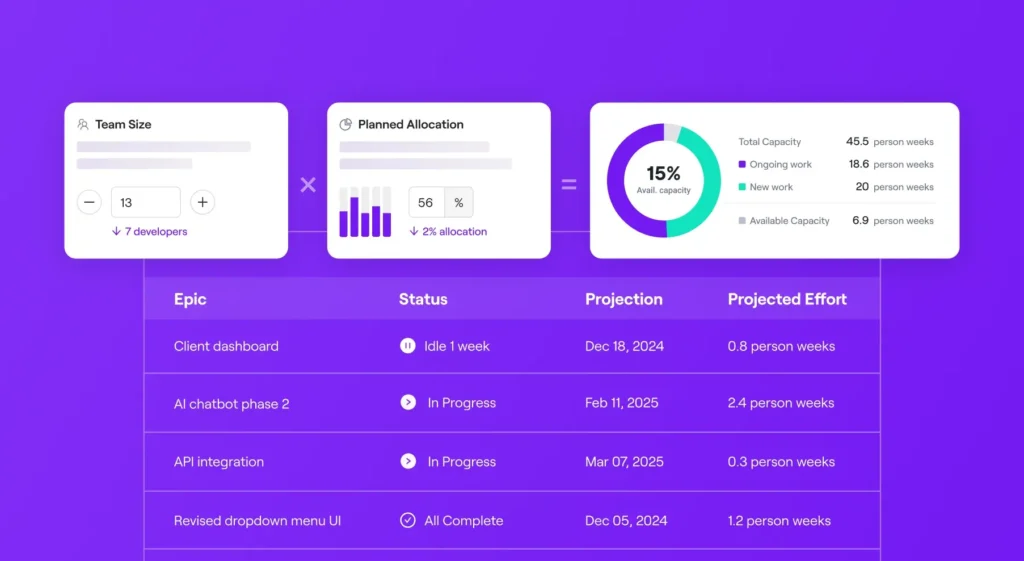Engineering is a process of discovery. You learn new things as you build and refine a product, and that process can take you in unexpected directions. Engineering organizations aim to align their efforts with a predetermined timeline, but let’s be honest — things rarely unfold as planned.
While engineering can be creative and unpredictable, SaaS businesses themselves are organized around when they have new products to sell. For a SaaS business to succeed, it needs the engineering team to provide concrete dates and expectations to inform every other aspect of the company’s operations. If the engineering team doesn’t meet those expectations, it will have a noticeable ripple effect throughout the organization — one that ends with unhappy customers and seriously unhappy executives.
Engineering and product leaders understand these pressures all too well — and it’s on them to bridge the gap with the business, communicating the timelines and trade-off considerations involved in achieving intended outcomes. Here’s how leaders can avoid misalignment and more effectively manage the delivery of new products and features.
Three Steps to Better Delivery Management
For engineering leaders, managing the tug-of-war between business leaders and the engineers themselves is a difficult task. Why? Because to an extent, both sides are right. Sales and marketing leaders are justified in expecting their colleagues to meet a delivery date. But at the same time, engineers want the product to be as good as possible.
To keep both sides of the equation in balance, engineering and product leaders must be able to predict bottlenecks, keep stakeholders updated on progress, and negotiate compromises when necessary.
- Predict bottlenecks and tradeoffs: No project takes place in a vacuum. An engineering leader should be able to draw on past experience to predict where a new product or feature might go off the rails. Past experience here doesn’t refer to memories and gut feelings — instead, it’s a matter of looking at engineering data to recognize common hurdles in the development process.
Once the engineering leader has a sense of where the potential roadblocks are hiding, they can then go through the thought exercise of predicting what will happen if they make one choice over another. How many people need to be working on a specific deliverable? Which team is best suited to getting the job done? What are the trade-offs involved between speed, budget and quality? Thinking through the consequences of each choice will often reveal the best path forward. - Overcommunicate progress and expectations: Other business leaders can forgive the engineering team when a project slips past a deadline; they can’t forgive being left in the dark. Engineering can’t afford to operate in a black box. Companies depend on engineering to drive the business forward, and they need the most accurate information possible to guide their efforts. Engineering and product leaders can help their colleagues by frequently updating them on any changes to the product itself and to the overall timeline.
Engineering work is often oriented towards speed — think “sprints” and “Agile” — but the engineering leader needs to take responsibility for keeping track of what turns are taken during a sprint. The small microdecisions that are made within a sprint may seem insignificant, but they can add up to serious changes for other areas of the organization. The engineering leader should take the time to collect and analyze data from the project; share that data with colleagues in sales, marketing, and finance; and give them an expert opinion on what the data means and how it could impact their work. - Negotiate compromises: Most importantly, engineering leaders need to recognize that no one else can make decisions on trade-offs. Business leaders will always want products to be delivered on time. Engineers want the product not to suck. The old engineering cliche of “you can have it on time, error-free and on-budget — pick two” is overplayed, but engineering leaders need to take responsibility for keeping these three factors in balance. The key is to make informed trade-offs: there is usually an effective compromise between speed, quality, and budget, as long as that compromise is communicated quickly and effectively — in terms every stakeholder can understand.
The solution to your engineering challenge may be to reduce scope and then update the product with fast follows, or it could be to expand the timeline slightly to allow for a more complete feature. Don’t fall victim to analysis paralysis: come up with a short list of potential solutions, including the potential implications of each option, and then bring that menu of choices to your colleagues in business leadership. If you can communicate the trade-offs and use data to back you up, you can help the organization move in the right direction.
Proactive Communication and Credible Data
There are two themes to effective delivery management: data-backed decision-making and proactive communication. Replacing gut feelings and emotions with data allows you to make decisions more quickly and build trust with colleagues. Proactive communication ensures that the entire organization is on the same page and rowing in the same direction.
Over time, this approach to delivery management allows engineering and product leaders to build cache throughout the organization — to gain a seat at the table with other business leaders. A SaaS business benefits when executives can count on their engineering leaders to deliver timely, trustworthy information. It makes life easier for everyone involved.
When engineers build trust and credibility among business leadership, everyone wins: engineering teams know their work is valued and understood; sales and marketing teams know that the engineering team has their back. The business can only succeed as a result.







